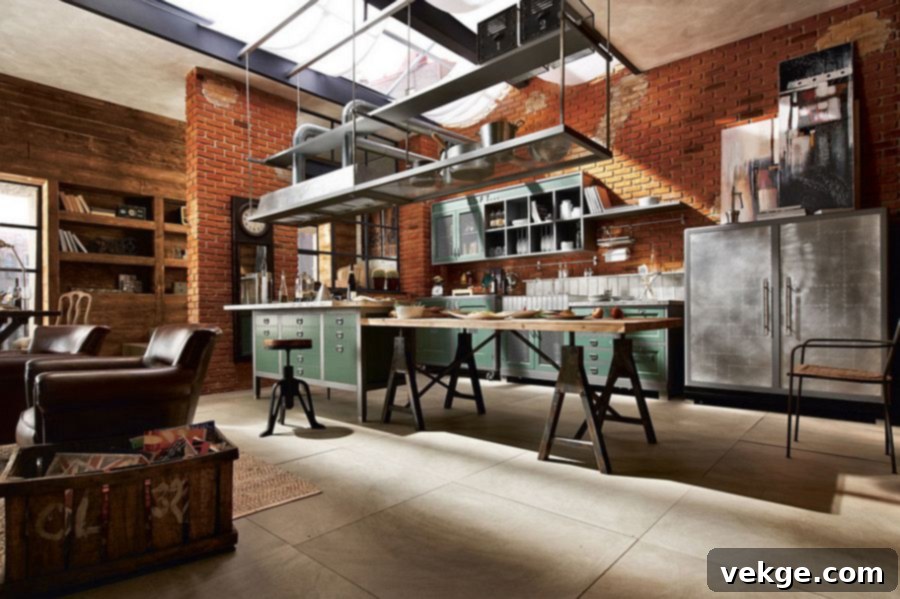Mastering Industrial Kitchen Design: Your Ultimate Guide to Styling & Accessories
Designing and decorating a kitchen from scratch can be a truly exhilarating experience, especially when you’re aiming for a distinctive style like industrial chic. The allure of an industrial kitchen lies in its ability to evoke the raw, expansive feel of a professional culinary space or a repurposed factory loft, even within a residential setting. While the concept might seem daunting at first, bringing those coveted industrial vibes into your home kitchen is entirely achievable with the right approach and a keen eye for detail.
This comprehensive guide is designed to demystify industrial kitchen design, offering you a wealth of practical tips and creative ideas for selecting the perfect accessories, materials, and decorative accents. We’ll delve deep into the core elements that define this timeless style, helping you transform your kitchen into a functional, aesthetically pleasing, and effortlessly cool space. Whether you’re planning a complete renovation or simply looking to inject some industrial character, keep reading to discover how to create a kitchen that truly stands out.
The Enduring Appeal of Industrial Kitchen Style
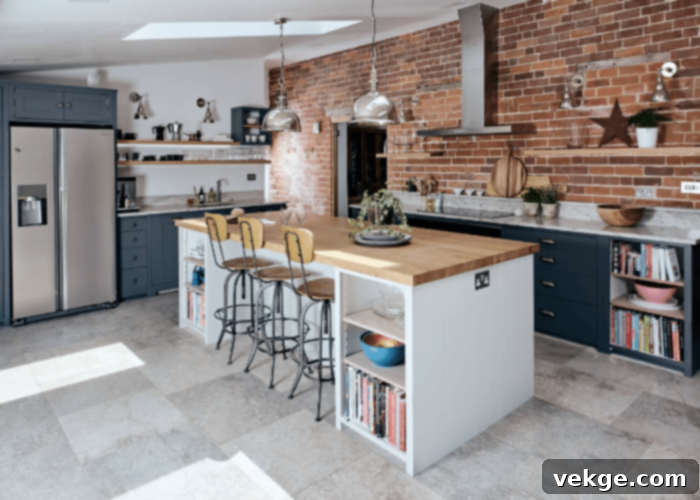
The industrial kitchen style has surged in popularity over recent years, captivating homeowners with its unique blend of rugged charm, versatility, and functional elegance. This design aesthetic draws its primary inspiration from old factories, warehouses, and industrial spaces, celebrating raw materials and utilitarian elements. It’s a look that champions exposed structures, minimalist forms, and robust finishes, creating an atmosphere that is both grounded and sophisticated.
Key characteristics often include the prominent use of natural, unfinished materials like exposed brick walls, concrete surfaces, and various metals such as stainless steel and wrought iron. Wooden elements, often reclaimed or distressed, add warmth and texture, balancing the harder industrial edges. The beauty of this style lies in its embrace of imperfections and its focus on functionality, making the kitchen feel spacious, breathable, and highly efficient. Industrial kitchens typically adopt a minimalist approach, emphasizing clear sightlines, ample workspace, and ingenious storage solutions that prioritize utility without sacrificing visual appeal. Open shelving, for instance, is a hallmark feature, maximizing storage while contributing to the open and airy feel characteristic of the style.
Beyond its aesthetic appeal, the industrial style fosters a sense of nostalgia, reminiscent of a bygone era of craftsmanship and heavy-duty utility. It’s a design choice that is both modern and timeless, creating a kitchen interior that is not only effective in design but also imbued with a rich, authentic character.
Essential Kitchen Accessories for an Industrial Look
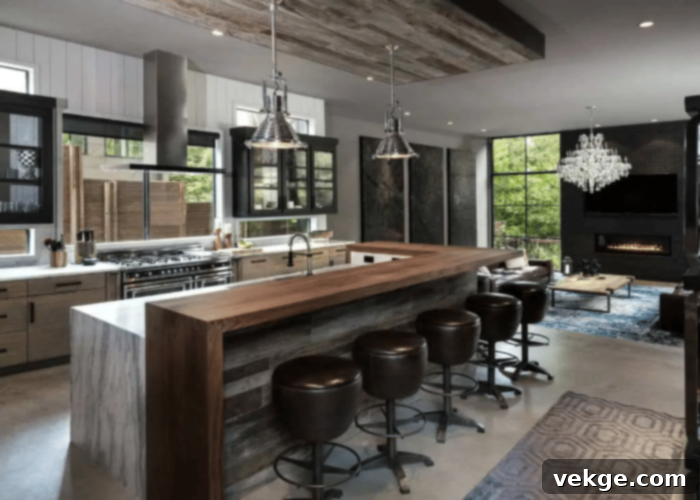
Accessories play a pivotal role in defining and enhancing the industrial aesthetic in your kitchen. They provide an opportunity to infuse specific design details and themes without overcomplicating the space. Thoughtfully chosen accessories can add elegant finishing touches, transforming your kitchen into an interesting and cohesive industrial-inspired environment.
1. Furnishings that Complement Industrial Vibes
Integrating core furniture pieces is a fundamental step in establishing an industrial look. Consider a robust kitchen island bench with a raw wood or concrete top, often supported by sturdy metal legs. Complement this with industrial-style bar stools, typically made from metal, wood, or a combination of both, featuring simple, clean lines. Glass-paneled cabinets or simple industrial-style pendant lights are also essential. These foundational elements are incredibly versatile, allowing you to easily redesign your kitchen interior. The beauty of these industrial kitchen accessories is their ability to seamlessly merge with existing decor, creating a cohesive and authentic feel. Even in smaller kitchens, these pieces are designed for efficiency, ensuring you retain ample breathable space while maximizing functionality.
2. Vintage and Repurposed Kitchen Items
To infuse genuine industrial character, incorporating vintage or repurposed items is a fantastic strategy. If a complete overhaul isn’t on your agenda, sourcing metal cupboards, dining tables with heavy-duty bases, and chairs reminiscent of old factory canteens can dramatically shift your kitchen’s ambiance. Think about reclaimed factory carts that can serve as mobile islands, or old tool chests repurposed into unique storage solutions. These items bring a sense of history and authenticity, giving your kitchen a truly unique industrial edge without requiring extensive structural changes.
3. Display-Worthy Kitchen Utensils and Storage
Industrial design often celebrates the utility of everyday objects. This means kitchen utensils and storage solutions can double as decorative elements. If your kitchen features a crisp white backsplash, displaying a collection of copper pots, cast-iron skillets, or stainless steel tools can create a striking visual impact. Open shelving, a cornerstone of industrial design, provides the perfect platform for organizing and showcasing jars, crockery, and other kitchen essentials. Arranging these items in a streamlined, artful manner elevates them from mere functional objects to integral components of your kitchen’s industrial theme, creating a practical yet aesthetically pleasing display.
The Industrial Kitchen Color Palette

An industrial-style kitchen typically embraces a minimalist color palette, focusing on neutral and saturated tones that convey a sense of gravitas and durability. Lighter, brighter colors are generally avoided in favor of hues that reflect the raw and utilitarian nature of the style. The primary colors are often drawn from the materials themselves, creating an organic and unpretentious backdrop.
Key saturated colors include rich tones like Brick Red, which mimics natural terracotta and exposed masonry, and Rust Orange, adding a warm, earthy industrial feel. Deep blues such as Navy Blue, Royal Blue, and darker shades of blue provide sophisticated contrasts. A spectrum of grays, including Slate, Charcoal, Dove Gray, and Cement Gray, form the backbone of many industrial designs, offering versatility and a modern edge. The classic contrast of Black and White is also frequently employed to create dramatic and impactful kitchens. These colors, when used together, create a robust and cohesive environment that perfectly complements the industrial aesthetic, allowing the textures and forms of the materials to truly shine.
Materials and Textures: The Foundation of Industrial Design

The choice of materials and textures is paramount in an industrial kitchen, as they are the very essence of the style. The look celebrates raw, unfinished, and robust elements, creating a tactile and visually engaging space.
Concrete and bricks are often the first and most ideal choices for industrial-style kitchens. They are popularly used for walls, creating striking backdrops, and also for countertops, offering durable and easy-to-maintain surfaces. Exposed brick, whether authentic or through the use of veneers, adds warmth and historical depth, while polished concrete provides a sleek, modern, yet rugged feel.
For cabinetry, open shelves, and wardrobes, materials like flat panels, metals (such as stainless steel or blackened steel), or various alloys are frequently utilized. Metal shelving units and frames are particularly effective for achieving that factory-floor aesthetic. When constructing a kitchen island in an industrial style, salvaged materials are highly prized. Reclaimed logs, old plumbing pipes repurposed as supports, and even parts of vintage machinery can add unique character. These are often combined with more traditional industrial materials like natural stones, large format tiles (especially in charcoal or grey tones), and concrete, creating a rich tapestry of textures and stories within the kitchen.
Decorative Accents for an Authentic Industrial Kitchen
Once the foundational elements of your industrial kitchen are in place, decorative accents provide the perfect opportunity to fine-tune the aesthetic, injecting personality and style. When selecting these accents, always consider the overall theme, the existing color palette of your kitchen walls, and your chosen accessories to ensure seamless integration and a harmonious look.
1. Strategic Color Injection
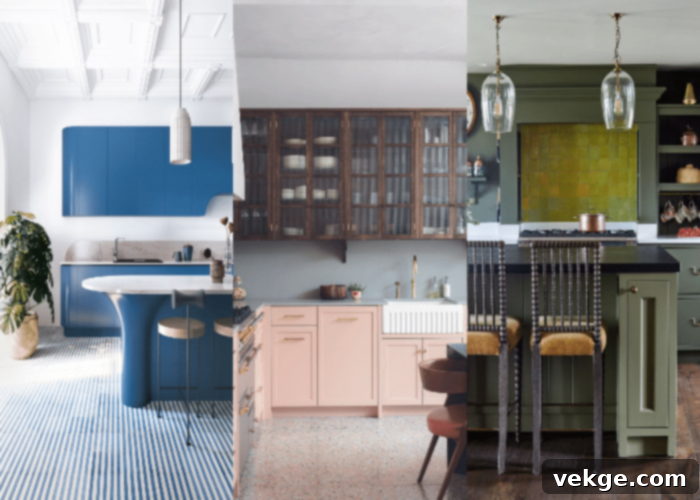
While industrial kitchens thrive on neutrals, injecting specific, bold colors can act as powerful decorative accents, adding dramatic elegance. For instance, consider painting the interior of an exposed metal shelf or the structural supports in a deep, saturated dark blue. Alternatively, use a vibrant Rust Orange to highlight window frames or a single accent wall, drawing the eye and breaking up the dominant neutral tones. These strategic bursts of color can define zones, add depth, and bring a contemporary twist to the classic industrial palette.
2. Statement Pendant Lights
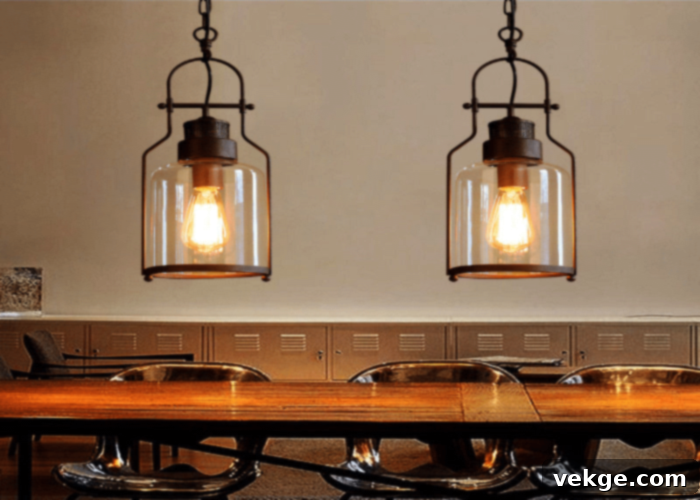
Lighting is an indispensable element in industrial design, not only for its functional purpose but also for its decorative impact. Pendant lights are particularly effective for incorporating industrial vibes. Look for fixtures made from metal (copper, brass, blackened steel), often featuring exposed bulbs (Edison bulbs are a favorite for their vintage charm) or cage designs. Hung above a kitchen island or dining area, they provide task lighting while simultaneously serving as elegant light fixtures that significantly contribute to the overall industrial aesthetic and balance the ambient light in the room.
3. Industrial-Style Lamps
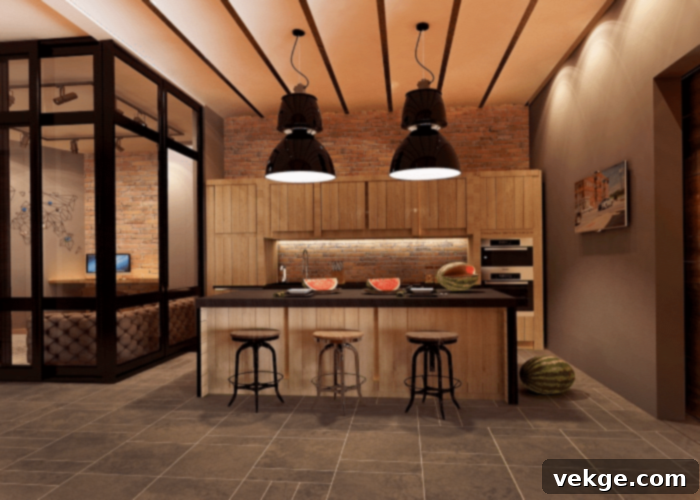
For a bolder, more dramatic touch that effortlessly introduces industrial flair, consider integrating black or grey industrial lamps. Think about large, articulated desk lamps, floor lamps with heavy bases, or wall-mounted sconces that mimic factory lighting. These pieces can instantly create a warm, inviting atmosphere, especially when paired with a kitchen painted in saturated colors like Rustic Orange, deep Charcoal, or other darker shades of neutral colors. The contrast between the lamp’s robust form and the rich background colors amplifies the industrial character, making the space feel both edgy and welcoming.
4. Industrial Detailing with Charcoal Tiles
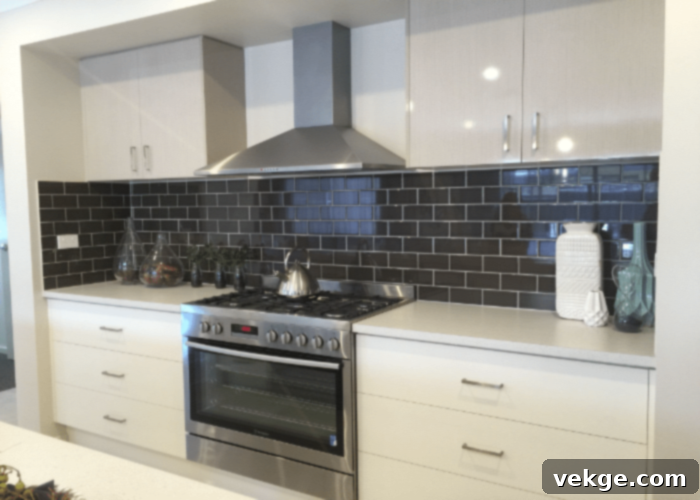
Incorporating tiles, particularly in shades like charcoal, is another excellent way to infuse an industrial touch into your kitchen. These tiles can be used creatively to establish specific industrial patterns on your floor, mimicking the durability of factory floors. They are also perfect for kitchen backsplashes, providing a clean yet rugged look, or for countertops, offering a resilient and stylish surface. The deep, muted tones of charcoal tiles complement other industrial materials beautifully, adding texture and depth without overwhelming the space.
Final Thoughts on Crafting Your Industrial Kitchen
For anyone drawn to modern and industrial aesthetics, the desire to integrate this distinctive style into their home kitchen is perfectly understandable. The journey to achieving this vision involves making informed choices about design elements, themes, accessories, and individual items, all while harmonizing with the unique size and architectural design of your home.
This guide has provided you with a comprehensive roadmap on how to accessorize and decorate your kitchen to effortlessly incorporate the raw, functional, and undeniably stylish vibes of industrial design. By focusing on materials, color palettes, and strategically chosen accents, you can transform your kitchen into a space that is both highly functional and visually captivating.
If you’re eager to discover more ways to enhance your home’s creativity and elegance, we invite you to sign up for our newsletter. Get our best strategies and inspiring ideas delivered directly to your inbox, helping you continue your journey toward a beautifully designed home.
